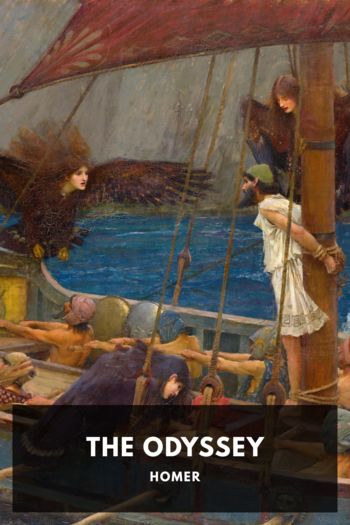The Cutthroat by Clive Cussler (popular books to read txt) 📗

- Author: Clive Cussler
Book online «The Cutthroat by Clive Cussler (popular books to read txt) 📗». Author Clive Cussler
“Isaac!” Van Dorn called after him. “Where the devil are you going?”
“England.”
ACT TWO
LONDON (SIX DAYS LATER)
14
“Fact-based truth, Mr. Bell,” Joel Wallace told Isaac Bell. “High-and-mighty Scotland Yard never nailed Jack the Ripper.”
When Americans ran into trouble abroad—businessmen swindled, tourists with daughters excited by shady suitors, art collectors worried that bargain-priced Rembrandts and Titians might have been lifted from their rightful owners—the lucky ones landed in Jermyn Street at the Van Dorn Detective Agency’s London field office.
Joel Wallace ramrodded the outfit. He was a short, rugged man in a loud suit, and he had made the Van Dorns a formidable presence in the capital city of the British Empire. The stuffier sort of Englishmen might be put off by his cocksure manner, but his brash ways assured Americans that Wallace was an aggressive detective they could count on, and word soon got around the expensive hotels and four-day ships: See Joel Wallace. The Van Dorns’ll set you straight.
“The Ripper ran circles around Scotland Yard. They won’t love a Yank reminding them.”
Which was precisely why Isaac would not want to present himself as Chief Investigator of a private detective agency. Better to let the high-and-mighty peer down their noses at a humble insurance sleuth who was indulging an eccentric hobby on his day off.
“Toyed with the coppers,” said Wallace. “Played tricks on ’em. You’re looking at his biggest joke right across the street—Metropolitan Police H.Q.”
It was a cold spring day, and the rain that greeted Bell’s ship at Southampton Docks and pelted the boat train was soaking London. Canvas topcoats were in order, for the walk past the cherry blossoms of St. James’s Park and across the Whitehall government district to the Victoria Embankment. Backs to the Thames, they faced New Scotland Yard, a double-wing, four-story building striped in horizontal rows of stone and brick. Soot-black Parliament buildings loomed just upriver. Scarlet trams rumbled on Westminster Bridge. Big Ben was striking two o’clock.
“New Scotland Yard—built the same year the Ripper started killing. One guess what the workmen found where they were laying the foundation.”
“Half a body,” said Isaac Bell. Five days steaming across the Atlantic Ocean in the Cunard liner Mauretania had been time to reread and ponder Research’s newspaper clippings and memorandums word by word. A phrase from the inquest stuck in his head. The butchered woman found in Scotland Yard’s cellar had been “well-nourished.” Hardly a description to fit the alcoholic prostitutes Jack the Ripper had murdered in the Whitechapel slum.
Bell was also intrigued by the coroner’s estimate that she had been dead as long as two months before her torso was discovered. If she was Jack the Ripper’s victim, could she have been his first?
“Nowhere near half a body,” Wallace corrected brusquely. “A third, at most. Torso, no arms, no head. Wrapped up in her dress.”
“Her dress?” asked Bell. “Or a man’s cape?” At the inquest, the cloth was described as “satin broche.” He had checked with Marion. Lightweight satin broche made dresses. But heavier broche weaves were fashioned into capes.
“Good question, which I can’t answer,” said Wallace. “Who knows what happened to the evidence so long ago. Seeing as how Scotland Yard insisted the Ripper hadn’t killed her—some other murderer did her. A couple of weeks later they dug up her arm. The Yard still swore it was coincidence.” He laughed. “Like some other Londoner just happened to be stashing chopped-up women under H.Q. that year.”
“Why would Scotland Yard lie?”
“How could they admit it was the Ripper? First, they can’t nail the louse. Then he rubs their faces in it. Bad enough to have her body dumped in their cellar—a body never identified, by the way—but dumped by Jack the Ripper? Too much, Mr. Bell. They might as well admit they missed the boat.”
Bell asked, “How corrupt were the cops back then?”
Like any field office chief worth his salt, Joel Wallace had made many friends in many walks of life. “From what the old-timers tell me, they didn’t have their hands out as much as ours, but they kowtowed to the upper crust even more. Still do. A so-called gentleman has to go to a lot of trouble to be suspected as a criminal, much less arrested.” He mimicked an upper class English accent: “‘Our sort doesn’t do that sort of thing . . .’ At any rate, the newspapers thought Jack the Ripper buried his victim there. So did everybody in London. So did most of the cops, but not the bosses. Listen, he had turned the town on its ear. They’d believe anything, and they were scared.”
“What do you think, Joel?”
“He’d have to be one heck of an athlete to carry even half a dead body into an unlit construction works in the middle of the night.”
“Why bother?” asked Bell. “Why risk getting caught or breaking his neck in the dark?” For a criminal who made a practice of not getting nailed, taking that kind of chance made no sense.
“My personal theory? Jack the Ripper had it in for the Police Commissioner.”
“Why?”
“Revenge for Bloody Sunday. There was a working class mob in Trafalgar Square. Socialists, radicals, and the Irish—England’s three favorite bogeymen in one conveniently located riot. The Commissioner ordered a billy club charge. Cavalry blocked the exits.”
This was news to Bell, who had had Grady Forrer’s Research boys go back only to the first Ripper killing. Proof—not that he needed it—of the value of traveling to the scene. “When was Bloody Sunday?”
“Year before,” said Wallace. “Ten thousand men and women attacked by club-swinging ‘bobbies.’”
“Does that make him a Socialist, or a radical, or Irish?”
“He could have been trampled. Or just an outraged witness. Don’t forget why Britons hate each other’s guts. Most are starving in filthy slums. The Army rejects four out of five recruits ’cause they’re sick and underfed. Can you imagine





Comments (0)